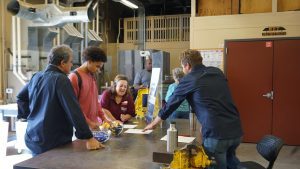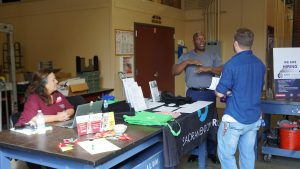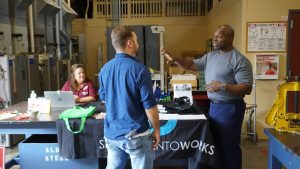 Los Rios-SETA partnership
Los Rios-SETA partnership
They’ve gone to class, nailed their studies, graduated … and they’re on the hunt for a job. Now what?
That’s where the going gets tough for some Los Rios Community College District (LRCCD) grads. Sure, they’ve put in the work necessary to get the credentials for entry positions in advanced manufacturing, allied health, hospitality or construction. But sealing the deal with a job offer often represents a whole new challenge.
Labor market statistics in the Greater Sacramento area offer some insight. While unemployment remains low at 3.4 percent, job growth in most sectors has slowed.
A tightening labor market can be especially hard on the population served by California’s community colleges, many of them first-generation college students, immigrants, and returning students look to upskill in a new field.
Enter the Sacramento Employment and Training Agency (SETA), part of the workforce development board, tasked with turning knowledge and skills into outcomes… and outcomes into incomes.
“They’re the hub for providing training throughout the Sacramento area,” explains Shinder Gill, PhD, District Dean of Workforce Development at Los Rios Community College.
For several decades, LRCCD has had an established partnership with SETA to provide essential training services to the county’s vulnerable populations leading to social and economic mobility.
“SETA has been a solid partner in our Strong Workforce Program (SWP) hosting job developers at our college sites-American River, Cosumnes River, Sacramento City and Folsom Lake – to match students and graduates with solid, high-paying jobs with growth opportunity,” says Dr. Gill.
LRCCD used Strong Workforce Funding to hire three part-time job developers and a job planner to connect with students across the four campuses. These efforts entail everything from setting up a table in the cafeteria or handing out flyers at an event, to speaking directly to students in their classes. The idea is to make them aware that SETA’s services are available to them at no cost. Those services include help with resumes, interview prep, demonstrating job research skills, or even coaching on how to answer behavioral questions.
The role of a job developer is part mentor, part matchmaker. According to Gill, they connect students with opportunities in particular industries, while guiding them on the skills, qualities, and experience that the employer is looking for.
“The whole purpose of SETA is to be sure [students] get a salary that allows them to be self-sufficient and puts them on a path upwards, agrees Workforce Development Planner Ira Ayers, who began at SETA several years ago as a job developer. “We’re not looking at low wage jobs; we’re looking at jobs averaging $22 an hour, with a trajectory for growth.”
Ayers cites an issue he encountered when he first began at SETA:
“I reached out to numerous employers to identify employment opportunities to refer students to,” he recalls. “I would reach out to students, seeking interested applicants to apply for those positions. Students did not respond for numerous reasons.”
Among those barriers were lack of career confidence, feelings of unpreparedness, and lack of familiarity with the services available. Facing these challenges, Ayers and the team at SETA realized they had to do several things. First: build up a rapport with students so that they know the services SETA offers and trusts its advice. Second: prepare students by exposing them to authentic, on-the-job experience. Finally: make the introductions necessary to get students in front of employers for a chance to interview..

Experience counts
Anderson Nobre graduated from Sacramento City College’s cybersecurity program in 2022, with the hope of working for the State of California. The SETA success story says the advice he got from his job developer made all the difference.
“He looked over my resume and cover letter, and I did some interview prep with him,” recalls Anderson. “But the biggest tip was that my resume was designed for the private sector, and he helped me gear it toward the state.”
Working with his job developer, Anderson created a plan to secure the state job he wanted.
“He … showed me how to go on to the Cal Career website, set up a profile, and use it as a template to adapt for different jobs. That was a game-changer.”
Nobre’s next steps included landing a Student Assistant position to get the experience the state required, working for six months, and taking additional courses to enhance his IT education. His experience supporting the California Department of Tax and Fee Administration as a student employee proved invaluable, both as a career experience and a résumé-builder.
“It’s extremely difficult for our graduates to compete against those from four-year colleges, so we create a pathway that allows our students to get the experience they need,” Ayers explains. “We collaborate with the internship coordinator on campus as well as utilizing the state platform for student assistant positions to identify internship opportunities.”
Strong Workforce Program funding is pivotal to the effort, incentivizing employers by paying for half of the student’s salary. The arrangement is a win-win for grads and employers, delivering students the on-the-job training they need to rise up within the industry, and giving employers the talent they need to get the job done.
Six months after his student position ended, Nobre was hired as an information technology associate in asset management. Now, he’s earning a living while learning the finer points of auditing and compliance. His goal is to one day become an information technology specialist, and he’s “100 percent, absolutely certain” that the job-hunting skills he’s learned will carry him forward when he’s ready to look for his next position.
Beyond cybersecurity and IT, SETA is sowing success across some of Northern California’s most in-demand industries. When Karen Itzel graduated from Cosumnes River College in May 2023 with a certificate in health information coding, she felt good about her skills, but less confident when it came to seeking a career.
“I had never done this before, and I found the whole process very intimidating,” Itzel reflects.
That all changed when she began working with her job developer, who she found “very motivating.
“He helped me structure my resume, and we did a couple of Zoom practice interviews.”
Thanks in part to the SETA experience, Karen not only landed a job as a medical office rep with Dignity Health, she managed to earn a promotion within three months. Now, she’s working on an associate degree, which will open the door for her ultimate goal: to be a health information coding specialist, perhaps at Stanford Medicine.
 It’s all about the outcomes
It’s all about the outcomes
With success stories like Nobre’s and Itzel’s taking shape, SETA is justifiably proud of its efforts so far. But with so much work to be done, the agency isn’t easing up on the accelerator.
“We are able to meet 176 placements this year, up from 150 last year, and we’ve consistently exceeded our wage objective, with an average starting salary of $26 per hour,” reports SETA Workforce Development Manager Lauren Mechals.
Meanwhile, Mechals and SETA are identifying challenges for students beyond résumé and interview prep. For many Northern California students, the most tenuous rung on the career ladder is access to basic needs. In fact, Mechals estimates that up to 20 percent of the students that SETA works with need this additional assistance.
“We’ve had to leverage additional funding to be able to bridge gaps in housing, food insecurity, and transportation,” says the manager. “Our job developers need to be good at assessing the customer’s needs … It may be about money, but it might also be about soft skills.”
With in-person services, including live appointments with job developers, returning, Mechals sees a bright future for the LRCCD partnership.
“The good news now is that we have an entire digital application process so students can meet with job developers in person or on Zoom,” she says. “Our developers can also go into virtual classrooms and talk to students.”
- *December 2023 statistic. See NFN_Report_LMIUpdate_APRIL_22-23_v3.pdf
April 2024